Key takeaways:
- Pro-life advocacy emphasizes the sanctity of life and fosters understanding through personal stories and empathy.
- Dialogue is crucial; creating safe spaces and using open-ended questions encourages diverse viewpoints and heartfelt exchanges.
- Sharing personal experiences can humanize complex issues, leading to deeper connections and understanding among community members.
- Building long-term relationships in advocacy requires intentionality and ongoing collaboration to strengthen community efforts.
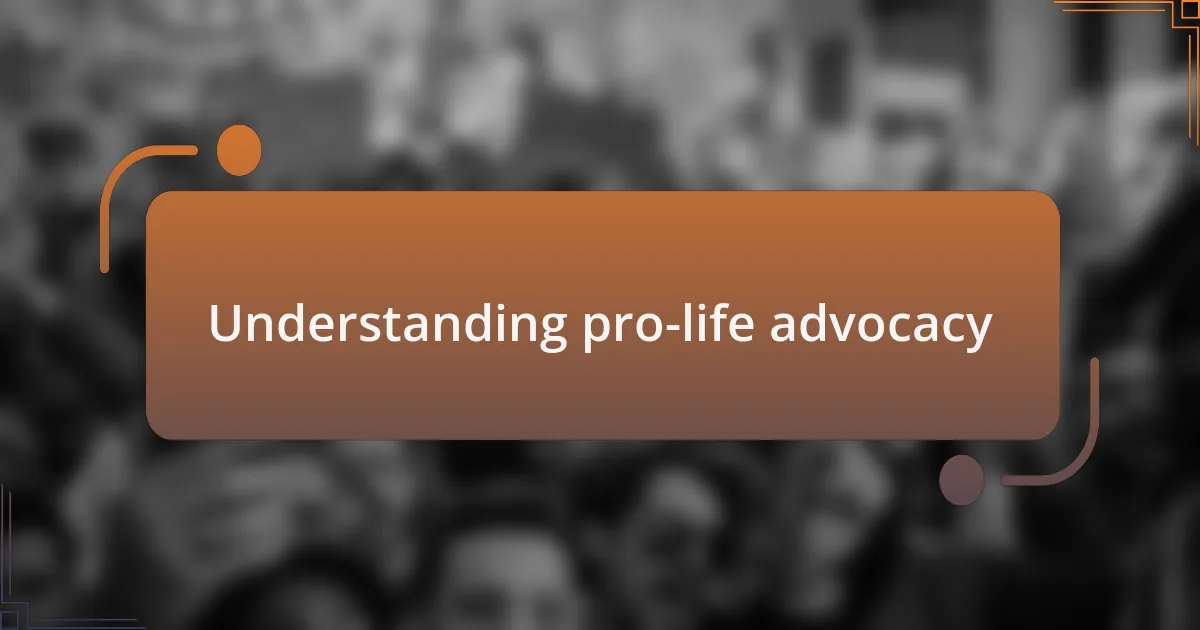
Understanding pro-life advocacy
Pro-life advocacy revolves around the belief in the sanctity of human life from conception to natural death. In my experience, discussions often center on the emotional stories of those affected by these choices, which highlights the deep personal connections that many have to this issue. When I hear someone share their journey, I can’t help but wonder how many lives are influenced by such powerful narratives.
One time, during a community event, a young woman shared her harrowing experience of considering an abortion. She spoke passionately about the support she received from pro-life advocates that ultimately led her to choose life for her child. Moments like these remind me of why advocating for life is about more than just a position; it’s about understanding and empathizing with diverse experiences.
As I have learned through dialogues within my community, pro-life advocacy is not just about opposing abortion; it encompasses a commitment to supporting parents, addressing poverty, and promoting adoption as loving alternatives. It raises the question of how we can better uplift those in difficult situations. Engaging with different viewpoints has opened my eyes to the complexities of this movement, highlighting the importance of compassion in our advocacy efforts.

Importance of dialogue in advocacy
When I think about the importance of dialogue in advocacy, I remember a gathering where diverse voices were sharing their perspectives. It struck me how conversations don’t just inform; they can transform. I often wonder, how can we truly advocate for life if we aren’t willing to listen to the experiences of those affected?
In a particularly enlightening discussion, a local pastor described the struggles faced by young women in crisis pregnancies. Hearing his heartfelt description of a single mother’s isolation made me reflect on how essential it is to create safe spaces for these dialogues. It raised a compelling question: what can we do to foster more understanding and compassion within the pro-life community?
Engaging in dialogue allows us to bridge gaps and build alliances, as I witnessed during a roundtable event with healthcare professionals and advocates. Each story brought forward reminded me that advocacy is not a one-size-fits-all journey; it requires our genuine willingness to understand and support each other’s narratives. Isn’t it liberating to know that through conversation, we can all contribute to a deeper understanding of life and its challenges?
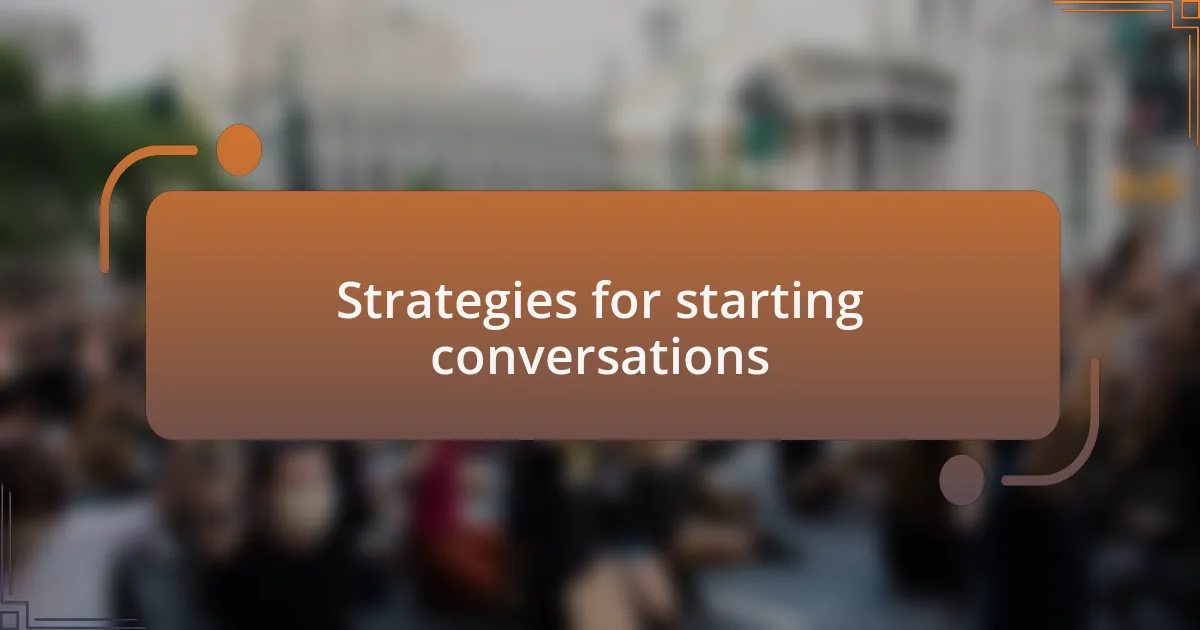
Strategies for starting conversations
One effective strategy for starting conversations is to begin with open-ended questions. For instance, I recall a time at a community event when I asked a simple question: “What does being pro-life mean to you personally?” The responses varied widely, but it created an inviting atmosphere where people felt comfortable sharing deeply held beliefs, sparking a lively exchange of ideas rather than a debate.
Another approach I’ve found valuable is sharing personal stories that relate to the topic at hand. When I shared my own experiences related to unexpected challenges and triumphs in life, I noticed how it encouraged others to open up about their journeys. This reciprocal sharing can create a poignant connection, making the dialogue not just informative but also heartfelt. Have you ever noticed how personal narratives can soften even the most contentious discussions?
Lastly, in my experience, using active listening can transform the way conversations unfold. I always strive to reflect back what others share, validating their feelings and perspectives. During a recent forum on reproductive health, one participant expressed frustration with feeling unheard. By acknowledging her viewpoint and expressing appreciation for her courage in sharing, the dialogue shifted from confrontation to collaboration. It made me realize that sometimes, just listening is the most powerful way to start a conversation.
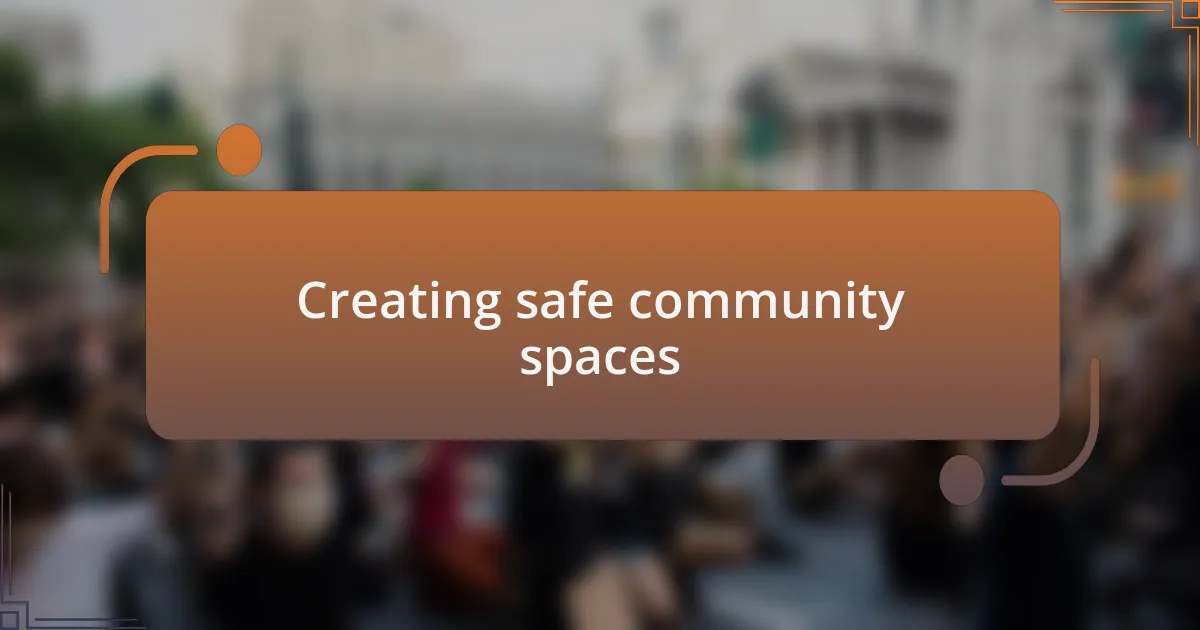
Creating safe community spaces
Creating safe spaces within the community has always been essential to fostering open dialogue. I remember organizing a local workshop where the environment was intentionally kept warm and welcoming. We set up soft lighting and comfortable seating, which seemed to put attendees at ease. The transformation was palpable; when people felt physically comfortable, they opened up emotionally, allowing for meaningful exchanges that wouldn’t have occurred in a more rigid setting.
Another effective element I’ve seen is incorporating ground rules that emphasize respect and understanding. At my last community meeting, we established guidelines that encouraged participants to speak from personal experience rather than making sweeping statements. This approach not only prevented heated arguments but also nurtured a sense of safety, inviting individuals to share their personal stories. It left me wondering—how often have you been in a discussion where the focus was on understanding rather than winning?
Furthermore, I’ve learned that inclusivity is vital in creating these safe spaces. I once noticed that certain voices in the room were overpowering others. It was then I realized that we needed to actively encourage quieter members to share their perspectives. I addressed this by asking specific individuals about their thoughts, which led to a more balanced dialogue. Have you ever seen how a small change, like inviting different voices, can enrich the conversation and foster unity?
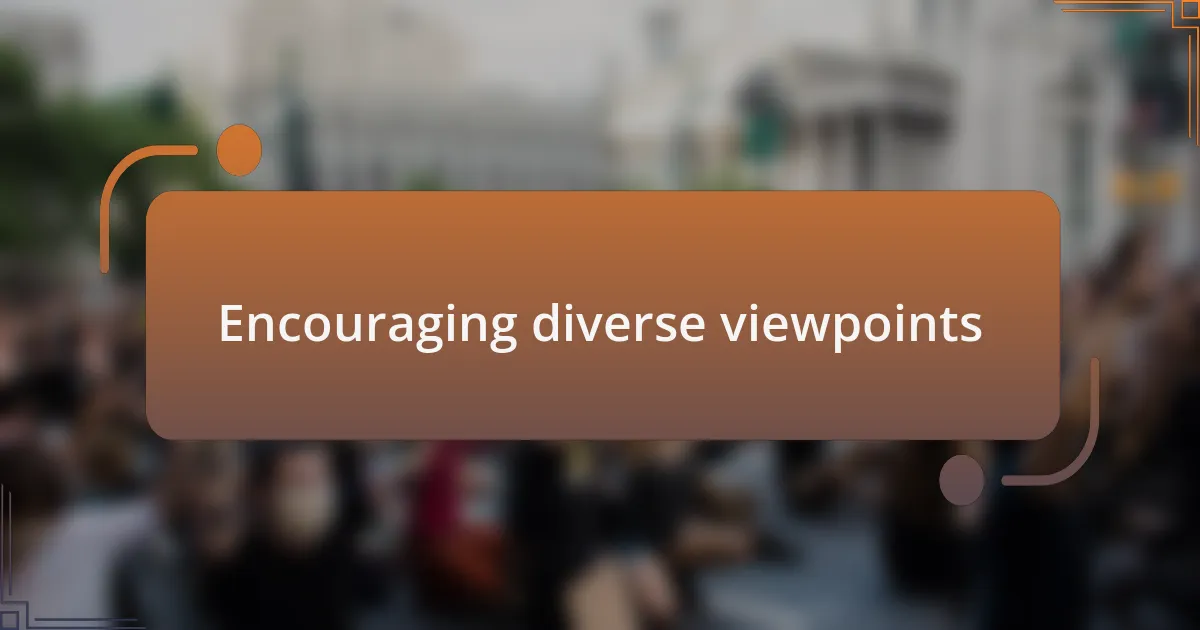
Encouraging diverse viewpoints
Encouraging diverse viewpoints requires an open-minded approach from everyone involved. At one gathering, I facilitated a “sharing circle,” where each person had the floor to express their thoughts without interruption. It was fascinating to see how different perspectives emerged, as people spoke from their own life experiences rather than theoretical ideals. I often ask myself: how much richer are our conversations when we truly listen?
I’ve found that actively seeking out individuals from various backgrounds not only enhances the dialogue but also fosters empathy. For instance, a friend of mine, who has a distinct cultural background, shared her story during a panel discussion we organized. Her insights had a profound impact on the listeners, challenging many preconceived notions. It made me realize that when we invite someone to share their unique viewpoint, we not only broaden our understanding but also create a tapestry of experiences that can inspire change.
In my experience, the key is always to embrace discomfort when engaging with different opinions. Initially, I felt nervous discussing contentious subjects, knowing that emotions could run high. However, I learned that thoughtfully navigating these conversations allows us to confront our biases and grow. I often wonder—what if we viewed conflicting opinions not as barriers, but as opportunities for personal growth and community strength?
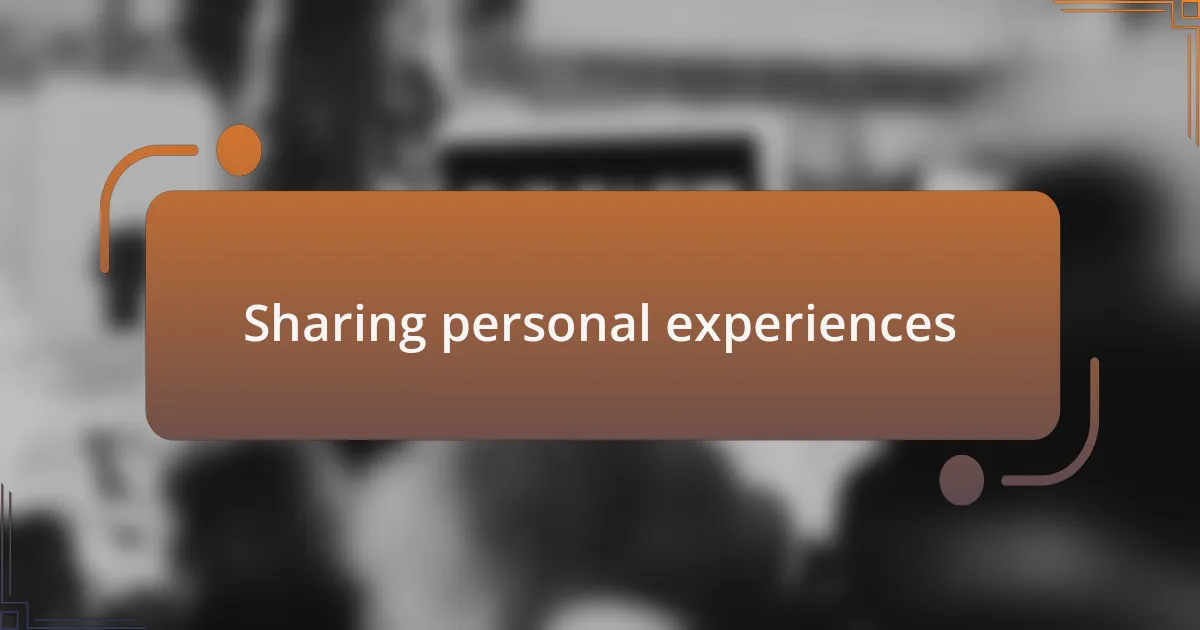
Sharing personal experiences
At one community meeting, I decided to share my own journey with a difficult personal choice I had faced. As I recounted my emotions and the challenges I encountered, I noticed a shift in the room. People began to nod, some even spoke up, connecting their own experiences to mine. It struck me how vulnerability can break down barriers, inviting others out from behind their walls.
Another time, I hosted a small coffee gathering where I shared my struggles with understanding the pro-life perspective in relation to my beliefs. The candidness of that conversation opened up space for others to reveal their uncertainties and hopes. It felt like we were all in a safe space, learning together. I still ask myself: how often do we miss the chance to build bridges due to fear of sharing our truths?
Reflecting on these moments, I understand that sharing personal stories allows us to humanize complex issues. One woman at the gathering shared a heart-wrenching story of loss, and I could feel the room enveloped in empathy. This reinforces my belief that when we share our experiences, we give others permission to do the same. It compels me to consider: how can we foster more of these heartfelt dialogues in our communities?
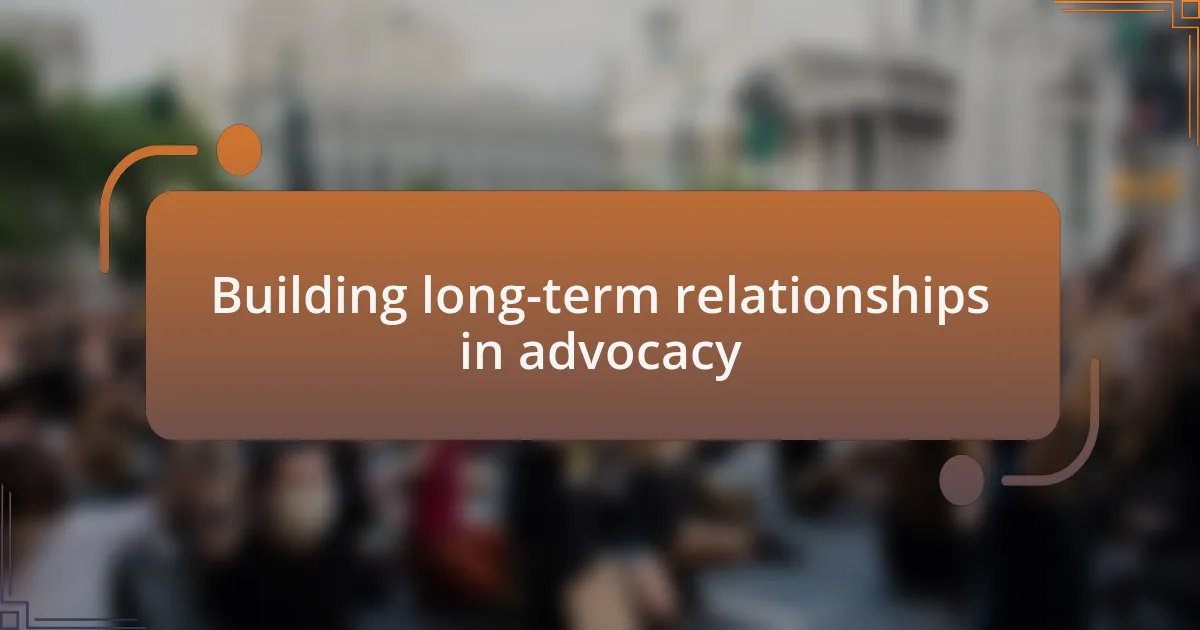
Building long-term relationships in advocacy
Building long-term relationships in advocacy requires intentionality and commitment. I recall attending a fundraising event where I struck up a conversation with a local activist. We continued to meet regularly for lunch, sharing updates on our projects and brainstorming new ideas together. Those simple meetings transformed into a partnership that amplified our voices in the community, demonstrating the power of ongoing collaboration.
One of my most rewarding experiences in building these relationships occurred during a weekend workshop I organized. I invited individuals from various backgrounds to discuss their views on pro-life advocacy. By encouraging open dialogue, we cultivated trust that allowed us to explore deeper issues. I often reflect on how vital it is to create environments where people feel valued; it fosters loyalty and strengthens our united front.
I often wonder, how many valuable connections are lost because of superficial interactions? One evening, while volunteering at a community outreach event, I made it a point to follow up with participants afterward. This simple act of checking in led to a series of collaborative initiatives that I had never imagined. It’s clear to me that commitment and follow-up are essential in nurturing relationships that are meaningful and impactful.